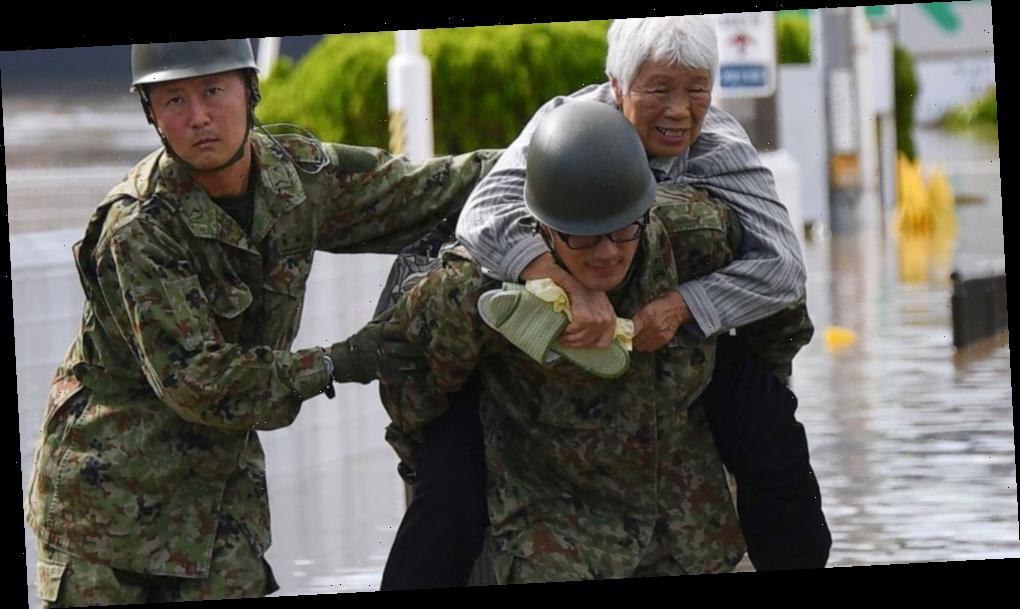Rescue crews in Japan dug through mudslides and searched near swollen rivers Monday as they looked for those missing from a typhoon that left as many as 36 dead and caused serious damage in central and northern Japan.
Typhoon Hagibis unleashed torrents of rain and strong winds Saturday that left thousands of homes on Japan’s main island flooded, damaged or without power.
Authorities warned more mudslides were possible with rain forecast for the affected area during the day Monday.
Kyodo News service, assembling information from a wide network, counted 36 deaths caused by the typhoon with 16 people missing. The official count from the Fire and Disaster Management Agency was 19 dead and 13 missing.
Hagibis dropped record amounts of rain for a period in some spots, according to meteorological officials, causing more than 20 rivers to overflow. In Kanagawa Prefecture, southwest of Tokyo, 100 centimeters (39 inches) of rainfall was recorded over the last 48 hours.
Some of the muddy waters in streets, fields and residential areas have subsided. But many places remained flooded, with homes and surrounding roads covered in mud and littered with broken wooden pieces and debris. Some places normally dry still looked like giant rivers.
Some who lined up for morning soup at evacuation shelters, which are housing 30,000 people, expressed concern about the homes they had left behind. Survivors and rescuers will also face colder weather with northern Japan turning chilly this week.
Rescue efforts were in full force with soldiers and firefighters from throughout Japan deployed. Helicopters could be seen plucking some of the stranded from higher floors and rooftops of submerged homes.
Prime Minister Shinzo Abe said the government will set up a special disaster team, including officials from various ministries, to deal with the fallout from the typhoon, including helping those in evacuation centers and boosting efforts to restore water and electricity to homes.
“Our response must be rapid and appropriate,” Abe said, stressing that many people remained missing and damage was extensive.
Damage was serious in Nagano prefecture, where an embankment of the Chikuma River broke. Areas in Miyagi and Fukushima prefectures in northern Japan were also badly flooded.
In such areas, rescue crew paddled in boats to each half-submerged home, calling out to anyone left stranded.
Tokyo Electric Power Co. said 56,800 homes were still without electricity Monday in Tokyo and nearby prefectures that the utility serves. Tohoku Electric Power Co. said 5,600 homes were without power in Miyagi, Iwate, Fukushima and Niigata.
East Japan Railway Co. said Hokuriku bullet trains were running Monday but reduced in frequency and limited to the Nagano city and Tokyo route.
An image of the aerodynamically curved bullet trains sitting in water, was seen by many as a sad but iconic symbol of the typhoon’s devastation.
Mimori Domoto, who works at Nagano craft beer-maker Yoho Brewing Co., said all 40 employees at her company had been confirmed safe. But deliveries had temporarily halted, and an event to promote the beer in Tokyo over the weekend was canceled for safety concerns.
“My heart aches when I think of the damage that happened in Nagano. Who would have thought it would get this bad?” she said.
Tama River in Tokyo also overflowed, but damage was not as great as other areas. Areas surrounding Tokyo, such as Tochigi, also suffered damage.
Much of life in Tokyo returned to normal. People were out and about in the city, trains were running, and store shelves left bare when people were stockpiling were replenished.
———
Follow Yuri Kageyama on Twitter at https://twitter.com/yurikageyama
On Instagram https://www.instagram.com/yurikageyama/?hl=en
Source: Read Full Article
